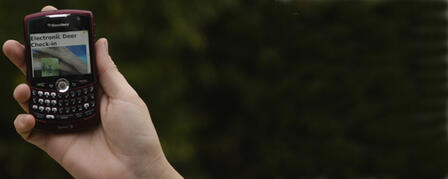KDWPT VOLUNTARY ELECTRONIC DEER REGISTRATION ONLINE ONLY

Nov. 10, 2011
Photo electronic deer registration helps hunters comply with interstate transportation laws; phone registration not an option
PRATT — Although the Kansas Department of Wildlife, Parks and Tourism (KDWPT) does not require registration of deer taken in Kansas, the agency does offer a voluntary option for transporting harvested deer that allows hunters to register their harvested deer through the Internet, using photos taken at the harvest site. Once registered, the hunter may then transport the carcass without the head or evidence of sex being attached (required for species- and sex-specific permits). To access the electronic deer check-in, go online to the KDWPT website, www.kdwpt.state.ks.us, and click “Hunting/Big Game/Deer/Deer Check-in.”
This is not a telephone registration system, and it is not required.
The registration process requires access to the KDWPT website through a conventional, wireless, or air-card Internet connection. Once logged on to the website, the hunter will need to submit two digital photographs — one close-up clearly showing the completed tag attached to the deer and a second showing the entire body of the deer with the head still attached. Hunters must enter the KDWPT number from their permits, time and date of the kill, and the county where the deer was taken. A confirmation number will be issued by email when the photos and data are successfully received. This confirmation number must be retained during transportation, so the hunter should write it down.
The hunter is walked through the registration process and given the necessary instructions. Once these steps are completed, the deer head may be removed and the carcass prepared for transportation. The system allows KDWPT staff to see the deer and the hunter’s completed tag without the time and expense of maintaining a check station. This flexibility is a benefit to both the hunter and KDWPT.
This option was developed to address two important issues regarding deer carcass transportation. The first concern is about the movement of any material from a deer that may contribute to the transmission of chronic wasting disease (CWD). While there is a lot yet to be learned about this disease, and how it is spread, it is believed that its transmission could be diminished if certain body parts affected by the disease are not moved from the site where the deer is taken. Because CWD affects the brain and central nervous system, the transportation of a deer head and skeleton from one location to another is considered a likely means for the disease to spread. The new registration system allows a hunter to leave these items at the kill site, minimizing the possibility of spreading the disease.
The second concern is directly related to the first. Many states have adopted strict regulations to prevent the spread of CWD. Typically, these regulations do not allow the transportation of a deer head with brain tissue from a state with confirmed CWD cases. Hunters have been cited in other states and had their deer confiscated for not complying with the transportation laws of that state. The new registration system allows a hunter to properly dispose of the head and legally transport the boned meat, as well as the cleaned skull cap and antlers, to the hunter’s home.
More information on CWD and transportation laws may be found on the KDWPT website under “Hunting/Big Game/Chronic Wasting Disease.”
-30-









